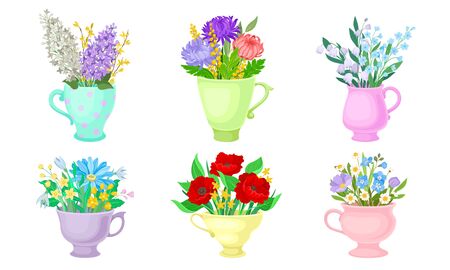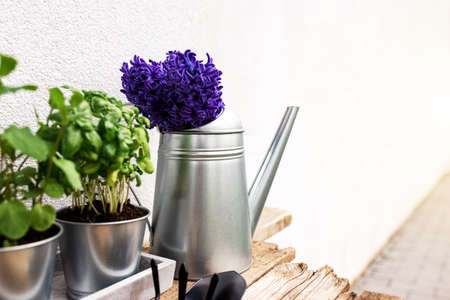Understanding Growing Zones and Seasonal Cycles
Before diving into what flowers to plant and when, it’s important to understand your local climate conditions. In the U.S., gardeners use the USDA Hardiness Zone Map to determine which plants are most likely to thrive in their area. These zones are based on the average annual minimum winter temperature, divided into 10°F zones.
What Are USDA Hardiness Zones?
The USDA Hardiness Zones range from Zone 1 (the coldest) to Zone 13 (the warmest). Most of the continental U.S. falls between Zones 3 and 10. Knowing your zone helps you choose flowers that can survive your region’s typical winter temperatures, which directly impacts planting times and bloom success.
Find Your Zone
You can find your specific zone by entering your zip code on the USDA Plant Hardiness Zone Map. This tool gives you a reliable starting point for seasonal planning.
How Seasons Affect Flower Gardening
Each season offers different opportunities for planting cut flowers. The key is understanding your frost dates—when to expect the last frost in spring and the first frost in fall. This window determines when its safe to plant outdoors without risking damage to young plants.
Typical Frost Dates by Region
| Region | Last Spring Frost | First Fall Frost |
|---|---|---|
| Northeast (Zone 5-6) | Late April – Early May | Mid October |
| Southeast (Zone 7-9) | Early March – Late March | Late October – November |
| Midwest (Zone 4-6) | Mid April – Early May | Early October – Mid October |
| Southwest (Zone 8-10) | Late February – Mid March | Late November – December |
| Pacific Northwest (Zone 7-9) | Mid March – Early April | Late October – November |
| California Coast (Zone 9-10) | No frost or very mild frost dates | No frost or very mild frost dates |
Why It Matters for Cut Flowers
Certain cut flowers prefer cooler weather, while others thrive in summer heat. For example, sweet peas do best when planted in early spring or even late fall in mild climates, while zinnias love warm soil and should be planted after all danger of frost has passed.
Quick Tip:
If you live in a warmer zone, like Zone 9 or 10, you may be able to grow multiple rounds of flowers year-round by staggering planting times.
Understanding your growing zone and seasonal cycle sets the foundation for a successful cut flower garden. Next, we’ll explore which flower varieties thrive in each season and how to plan your garden accordingly.
2. Spring Blooms: Early Color and Cool-Weather Varieties
As winter fades and the days begin to warm, early spring is the perfect time to plant cool-weather cut flowers that bring vibrant color to your garden—and your vases. These blooms thrive in mild temperatures and often bloom before the heat of summer arrives. Whether youre in USDA Zone 5 or Zone 9, planning ahead for spring flowers ensures a longer cutting season and more variety in your arrangements.
Top Early Spring Cut Flowers
Here are some popular spring-blooming cut flowers that do well when planted in late winter or early spring, depending on your zone:
| Flower | Ideal Planting Time | USDA Zones | Bloom Time |
|---|---|---|---|
| Ranunculus | Late winter to early spring | Zones 8–10 (pre-sprout indoors for colder zones) | Spring to early summer |
| Tulips | Fall (chill bulbs), early spring if pre-chilled | Zones 3–8 | Mid to late spring |
| Anemones | Late winter to early spring | Zones 7–10 (start indoors in colder zones) | Early to mid spring |
| Iceland Poppies | Late fall or early spring | Zones 4–9 | Spring through early summer |
| Larkspur | Late fall or very early spring | Zones 6–9 | Late spring to early summer |
| Daffodils (Narcissus) | Fall (bulbs) | Zones 3–8 | Early to mid spring |
| Snapdragons (early varieties) | Late winter to early spring (indoors or under cover) | Zones 7–10+ | Spring through early summer |
Tips for Success with Spring Bloomers
Select the Right Varieties for Your Zone
If you live in a cooler climate, opt for hardy annuals like larkspur, snapdragons, and Iceland poppies. In warmer regions, you can take advantage of an earlier start with pre-sprouted ranunculus and anemones.
Start Indoors When Needed
Certain varieties like ranunculus and anemones benefit from starting indoors in trays or pots about 6–8 weeks before your last frost date. This gives them a head start and protects them from any lingering cold snaps.
Add Mulch for Temperature Control
A layer of mulch around your young plants helps regulate soil temperature and retain moisture during unpredictable spring weather.
Stagger Plantings for Extended Blooms
If possible, stagger your planting times by a week or two. This spreads out bloom times and keeps your garden—and your vases—full of fresh flowers throughout the season.
Quick Tip:
If youre short on space, try growing these cool-season flowers in raised beds or containers. They warm up faster than ground soil and offer better drainage during wet spring months.
The key to beautiful spring bouquets starts with understanding which flowers thrive in cool weather and how to give them the best start. With a little planning, your garden will be bursting with color just as the season begins.

3. Summer Stunners: Heat-Loving Annuals and Perennials
Summer is the season when your cut flower garden can truly shine with bold colors and abundant blooms. As temperatures rise, it’s time to focus on heat-tolerant annuals and perennials that thrive in full sun and reward you with continuous flowers for fresh bouquets. Choosing the right varieties and practicing smart harvesting techniques will keep your garden looking beautiful all summer long.
Zinnias: The MVP of Summer Gardens
Zinnias are a must-have for any summer cutting garden. They come in a wide range of colors, from soft pastels to vivid brights, and they bloom non-stop until frost. These fast-growing annuals love the heat and are very easy to grow from seed directly sown into the garden after the last frost date.
Growing Tips:
- Plant in full sun with well-drained soil
- Space plants 6–12 inches apart for good air circulation
- Deadhead or harvest regularly to encourage more blooms
Sunflowers: Tall, Cheerful, and Eye-Catching
Sunflowers bring height and drama to your summer arrangements. Whether you choose branching varieties for multiple stems or single-stem types for big impact, these iconic American favorites are easy to grow and make a bold statement in any bouquet.
Growing Tips:
- Sow seeds directly in sunny spots after the danger of frost has passed
- Stake taller varieties to prevent wind damage
- Harvest when petals just begin to open for longer vase life
Cosmos: Delicate Blooms with Big Impact
Cosmos are another excellent choice for hot summer gardens. Their airy, fern-like foliage and daisy-like flowers add a whimsical touch to floral designs. They’re drought-tolerant once established and bloom prolifically with regular picking.
Growing Tips:
- Direct sow or transplant into full sun after last frost
- Avoid over-fertilizing, which can lead to more foliage than flowers
- Pinch young plants at 12 inches tall to encourage bushier growth
Keep the Blooms Coming: Succession Planting & Harvesting Tips
If you want fresh flowers all summer long, succession planting is key. This means planting new seeds every few weeks so you always have plants at different stages of growth. Combine this with regular harvesting and deadheading to maximize flower production.
Succession Planting Schedule (Example)
| Flower Type | Initial Planting | Second Planting | Third Planting |
|---|---|---|---|
| Zinnias | Late May | Mid-June | Early July |
| Sunflowers (single-stem) | Late May | Early June | Late June |
| Cosmos | Late May | Mid-June | N/A (long blooming) |
Harvesting Tips:
- Cut flowers early in the morning or late evening for best hydration
- Use clean tools and place stems immediately in water
- The more you harvest, the more your plants will produce!
Your summer cut flower garden can be both productive and stunning with just a little planning. Focus on reliable heat-lovers like zinnias, sunflowers, and cosmos, and practice succession planting to enjoy vibrant blooms week after week throughout the season.
4. Fall Favorites: Late Bloomers and Overwintering Prep
As summer fades and cooler temperatures roll in, fall becomes a surprisingly vibrant time for cut flower gardening. Many flowers actually thrive in the crisp autumn air, offering rich colors and textures perfect for late-season arrangements. This is also the ideal time to prep your garden for winter and plan ahead for spring blooms.
Best Flowers to Plant or Harvest in Fall
Some flowers bloom late into the season or can be planted in early fall for either immediate blooms or overwintering success. Heres a quick guide to popular fall-friendly cut flowers:
| Flower | Planting Time | Notes |
|---|---|---|
| Chrysanthemums (Mums) | Late summer to early fall | Classic fall bloomers with bold colors; pinch back early for bushier growth |
| Asters | Early spring or late summer | Late bloomers that attract pollinators; great for adding purple tones |
| Dahlias | Spring (for fall blooms) | Continue blooming until frost; dig up tubers after first frost to store over winter |
| Snapdragons | Late summer or fall (in mild climates) | Tolerate light frost; can overwinter in USDA zones 7 and up |
| Pansies & Violas | Early fall | Cool-weather favorites that can overwinter and rebloom in spring in many areas |
Preparing Your Garden for Overwintering
Fall isn’t just about enjoying the last blooms—it’s also a key time to get ready for next year’s garden. Here are some simple steps to help your garden transition into winter smoothly:
- Clean Up: Remove spent annuals, dead foliage, and any diseased plant material to prevent pests and diseases from overwintering.
- Cut Back Perennials: Trim perennials like echinacea and yarrow down to a few inches above the ground once they’ve finished blooming.
- Mulch Beds: Add a layer of mulch (like straw, shredded leaves, or compost) around plants to protect roots from temperature swings and erosion.
- Divide Bulbs & Tubers: Lift dahlia tubers, gladiolus corms, and other tender bulbs before the first hard frost. Store them in a cool, dry place.
- Sow Cool-Season Seeds: In regions with mild winters (USDA zones 7+), you can directly sow hardy annuals like larkspur, bachelor buttons, and poppies now—they’ll establish roots through winter and bloom earlier in spring.
Tips by USDA Hardiness Zone
| Zone | Fall Gardening Tips |
|---|---|
| Zones 3–6 | Focus on harvesting late bloomers; lift tender bulbs early; heavy mulching recommended. |
| Zones 7–8 | Sow hardy annuals now; many perennials will survive winter with minimal protection. |
| Zones 9–10 | You can grow cool-season flowers all winter; avoid planting heat-loving varieties until spring. |
A Few Extra Fall Flower Favorites:
- Sedum: Great structure and color as the season winds down.
- Anemones (Fall-blooming): Delicate petals with strong stems—perfect for vases.
- Celosia: Unique texture and fiery colors make it a standout in autumn bouquets.
Your Autumn Garden Toolkit:
- Burlap or Frost Cloth: For covering sensitive plants when unexpected frosts hit early.
- Dibber or Bulb Planter: Makes sowing bulbs or transplanting seedlings easier.
- Labeled Storage Containers: Ideal for keeping lifted tubers organized over winter.
This season is all about savoring the final blooms while setting the stage for next years success. With thoughtful planting and preparation, your cut flower garden can flourish well beyond the first frost.
5. Winter Strategies: Planning, Prepping, and Indoor Sowing
Just because your garden might be under a blanket of snow doesn’t mean the growing season is on hold. Winter is actually one of the best times to lay the groundwork for a thriving cut flower garden come spring. With the right strategies, you can use these colder months to get ahead by planning your garden layout, prepping your soil, and even starting seeds indoors.
Garden Planning: Dream It Now, Grow It Later
Start by evaluating what worked and what didn’t in your flower beds last year. Did certain flowers bloom better than others? Were there gaps in color during some weeks? Use this time to sketch out a rough plan for your upcoming garden. Think about bloom times, color schemes, and plant heights to create beautiful bouquets all season long.
Helpful Planning Tips:
- Use a calendar or garden planner to map out planting and bloom times.
- Group flowers by season (spring, summer, fall) for continuous blooms.
- Consider succession planting for extended harvests.
Soil Prep: Start from the Ground Up
While you may not be able to dig into frozen ground, winter is a good time to improve your soil health. Test your soil’s pH and nutrient levels using a home kit or through a local extension office. Based on the results, you can plan amendments like compost, lime, or organic fertilizers so theyre ready to go when the ground thaws.
Basic Soil Amendment Chart:
| Soil Issue | Recommended Amendment | When to Apply |
|---|---|---|
| Low pH (Acidic) | Lime | Late winter/early spring |
| Poor Drainage | Compost or sand | Before planting season |
| Nutrient Deficiency | Organic fertilizer or compost | Early spring |
Indoor Seed Starting: Get a Head Start
Many popular cut flowers benefit from an early indoor start. This gives them extra time to grow strong before being transplanted outdoors after the last frost. All you need are some seed trays, quality potting mix, and a sunny windowsill or grow lights.
Popular Cut Flowers to Start Indoors in Winter:
| Flower Variety | Start Indoors | Transplant Outdoors |
|---|---|---|
| Snapdragons | 10-12 weeks before last frost | After hardening off in early spring |
| Zinnias | 4-6 weeks before last frost | Once soil has warmed up |
| Celosia | 6-8 weeks before last frost | Soon after danger of frost passes |
Pro Tip:
If youre short on space or new to seed-starting, consider focusing on just a few tried-and-true varieties your first year. This helps build confidence and keeps things manageable.
Taking time during winter to plan ahead sets you up for success when spring arrives. From getting seeds started indoors to improving your soil health and organizing your planting schedule, each step brings you closer to a flourishing cut flower garden that will reward you all year long.


